Batteries not included… no worries, I have plenty here in this drawer. Uh oh, are they all dead? Ahh, it must be Christmas time. In today’s tip we are going to show you a quick way to test those batteries because all it takes is for one bad battery in the set to leave you believing all of them are dead.
Need a Christmas Present?
Below is probably one of the best things you can get as a homeowner (or remodeler) if you do any work on your house or others. This is a electrical test kit which can be a godsend when you are trying to diagnose issues, like why isn’t XY or Z running. The outlet tester & voltage detector most people easily get how to use. The multimeter though can be confusing for many & leads us to todays tip.
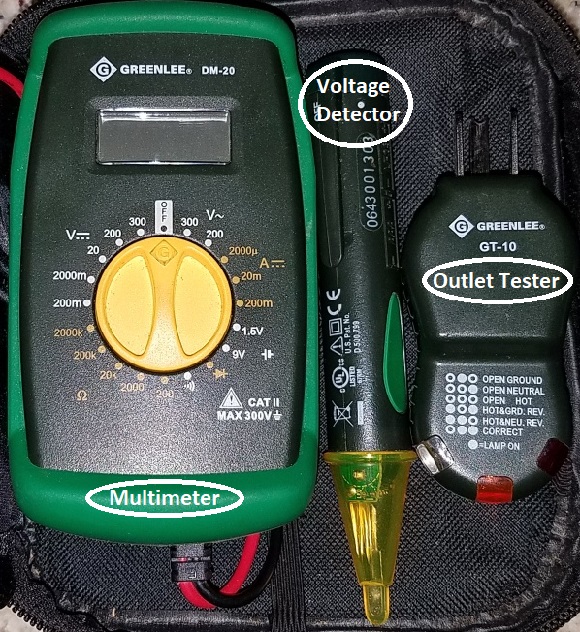
The multimeter & testing batteries:
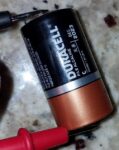 One look at the dial can turn many away but in reality it is a simple testing tool once you start using it. In the case of batteries most units have a spot for checking 1.5 & 9 volt batteries. You can see I selected the 1.5V which is good for AAA, AA, C, & D batteries. You can see just below that selection is the 9 volt test.
One look at the dial can turn many away but in reality it is a simple testing tool once you start using it. In the case of batteries most units have a spot for checking 1.5 & 9 volt batteries. You can see I selected the 1.5V which is good for AAA, AA, C, & D batteries. You can see just below that selection is the 9 volt test.
Testing is easy – first select the proper test then place the black probe on the “negative” side & the red probe on the positive side. No worries if you do it backwards (at least on this version) as it will just read a negative number but still let you know the battery is good. As an FYI, you can actually touch the leads with your fingers if you are having problems holding a reading.
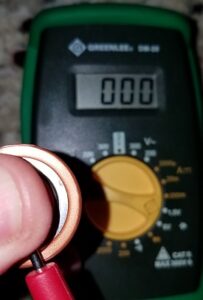
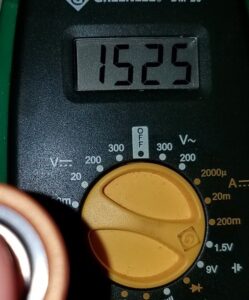 The one on the left shows a battery is truly dead, while the one on the right shows a brand new battery. For most rechargeable batteries you will only get a reading of around 1,300 which is one reason why it seems that those batteries don’t last as long or can’t seem to power all devices. But more on that later…
The one on the left shows a battery is truly dead, while the one on the right shows a brand new battery. For most rechargeable batteries you will only get a reading of around 1,300 which is one reason why it seems that those batteries don’t last as long or can’t seem to power all devices. But more on that later…
Wait I have an Analog version:
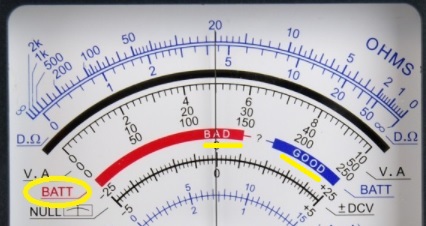 Most analog versions also have a similar setting for batteries & might even have a specific band for reading the results as shown. You may notice that it has a “good” versus “bad” section as a battery might have juice still, but not enough. As mentioned above, more on that is just a minute…
Most analog versions also have a similar setting for batteries & might even have a specific band for reading the results as shown. You may notice that it has a “good” versus “bad” section as a battery might have juice still, but not enough. As mentioned above, more on that is just a minute…
Wait, mine doesn’t have a Battery test option:
I really don’t like the normal test option above as it doesn’t really show the volts but if you switch over to the “20” on the DV volt side you will get an actual voltage reading. If your has a “10” that would be even better as the closer to true voltage you get, the better the reading will be.
Battery Voltage & Devices:
Batteries start off at a certain voltage and as they are used the available voltage decreases. Interestingly regular batteries are listed & test out at 1.5+ volts while rechargeable batteries NiCd, NiMh come in generally around at 1.25 volts (yes even if listed at 1.5). This as mentioned earlier can be one reason why rechargeable batteries never seem to work as well nor last as long. Lithium Ion rechargeable used to come in at 1.3 but newer ones are supposedly coming in at the 1.5 volt mark.
Fortunately for devices that use batteries, they can handle the differing amounts of power available but at a certain point of voltage drop the device will no longer work, even if there is a few volts left to squeeze out. That is why most say once a battery drops below 1.2 volts it is generally time to trash it though you might luck out with some generic LED flashlights that can drop down to .9 volts.
Last tip: Always check “dead” batteries
Ever had a remote or even a toy that apparently was dead or was dying & you flipped the batteries and all of a sudden it was fine? Well that is because instead of the device draining all the batteries equally it is only draining one or more at a time. So instead of just popping all the batteries out and tossing them, you might want to check them all first. As for the old wives tale of never mixing new with the old, well it does hold a measure of truth for some devices but not for devices like this.
